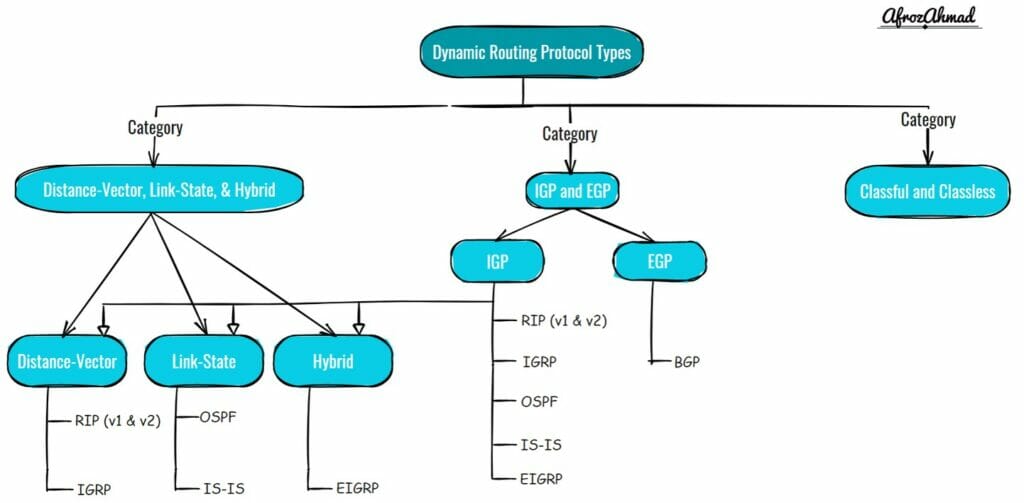Picking the best dynamic routing protocols is key to managing your network well and moving data correctly. You can choose from Exterior Routing Protocols like BGP or Interior Routing Protocols like Distance-Vector (RIPv2), Link-state(OSPF & IS-IS), and Hybrid(EIGRP). Make sure the protocol you choose fits your network’s size, how complex it is, and what it needs to do.

Key Takeaways
- 🌐 Dynamic routing protocols enable routers to automatically update their routing tables, enhancing network efficiency and reliability.
- 🔧 There are three main types of routing protocols: Distance-vector, link-state, and hybrid, each suited for different network sizes and complexities.
- 🔄 Dynamic routing offers automatic path updates which are beneficial for managing changes in network topology, unlike static routing that requires manual updates.
- 💻 Routing protocols are essential for routers to exchange information, determine the optimal data paths, and ensure data packets are correctly forwarded to their destinations.
- 🛠️ Hybrid routing protocols like EIGRP combine the best features of both distance vector and link-state approaches, offering flexibility and efficiency.
- 🌍 Exterior Gateway Protocols (EGP) and Interior Gateway Protocols (IGP) cater to routing needs between and within different administrative domains, respectively.
- 🆚 Classful and classless routing protocols differ in how they manage IP addresses and subnet information, impacting network organization and data routing efficiency.
- 🔍 Routing protocols also play a crucial role in network security by enabling routers to authenticate updates and manage routing information securely.
What are Routing Protocols?
Routing protocols are rules used by routers to share information. This information helps them decide the best path for sending data across a network. Essentially, routing protocols help routers build a “map” (known as a routing table) of the best routes to take.
Types of Routing Protocols
There are two main types of routing protocols:
- Static Routing: Here, a network administrator sets up the routing paths manually. It doesn’t change unless the administrator changes it.
- Dynamic Routing: This type allows routers to exchange routing information automatically. They adjust the routing paths (routing table) as the network changes.
What Do Routing Protocols Do?
Routing protocols are rules that help routers send information to each other. Here’s what they do:
Find the Best Path: Routing protocols help routers find the most efficient ways to send data packets. This makes the data sending process more reliable and cuts down on mistakes.
- Share Information: These protocols let routers share updates about the network. Routers use this data to refresh their routing tables automatically. This means they do not need a person to help them update.
- Keep Routing Tables Updated: Routers exchange messages that follow these protocols to keep their routing tables fresh. A routing table is like a map for the router, showing the best paths to different network parts.
- Send Data: When a router receives data, it decides where to send it. It looks at its routing table to choose the best route.
- Route the Data: If the router knows the path, it sends the data along to the next router. If it doesn’t know, it might send the data to a default gateway or discard it.
- Adjust to Changes: If the network changes—for example, if parts of the network go down or come back online—routers quickly update each other. This helps them learn new paths and find other ways if there are problems on the current path.
- Reduce Work for Administrators: Dynamic routing needs less manual work from network managers because it handles these updates on its own.
Static vs. Dynamic Routing:
Dynamic routing uses some of the router’s resources, like processing power and bandwidth. This is the cost for its automatic features. However, in simpler setups, static routing might be better. For example, manually setting a default route can be easier than setting up a dynamic routing protocol. In less complex networks, you might use both static and dynamic routing.
Goals of Routing protocols:
The primary goal of routing protocols is to ensure that all routers have accurate and up-to-date information about the network to make the best decisions about how to route traffic.
Routing protocols also aim to reduce network traffic by determining the most efficient path between two points.

Common Routing Protocols Categories:-
Depending on factors like the algorithm used to calculate the best route and how much of the network a routing protocol can span, etc.
You can categorize routing protocols into three groups, each with its own set of common protocol types.
Distance Vector, Link-state, and Hybrid Protocols
Distance vector protocols use the Bellman-Ford algorithm and measure distance in hops to calculate the shortest path to a destination. The number of hops is equivalent to the number of routers the data passes through before it reaches its destination. The Routing Information Protocol (RIP) is the most common distance vector protocol.
Link-state protocols, on the other hand, use the Dijkstra algorithm and create a map of the network with nearby routers running the same routing protocol. Link-state protocols calculate the shortest path to a destination by measuring the speed of the links and the total cost of the path to a destination. In Addition, Link-state protocols calculate the best path to a destination by considering all available paths. The most common link-state protocol is Open Shortest Path First (OSPF).
Lastly, Hybrid protocols are designed to take advantage of the best features of both distance vector and link-state routing protocols. One example is EIGRP, which uses a combination of these two methods and it is a Cisco proprietary protocol.
Interior Gateway Protocol (IGP) and Exterior Gateway Protocol (EGP)
We can select routing protocols based on the Administrative domain in this category. IGP exchanges routing information between hosts within a single network or administrative domain. On the other hand, EGP is used to exchange routing information between different networks or administrative domains.
Interior gateway protocols connect routers in the same autonomous system; this might be a single routing network or a group of networks under the control of a single company or authority. IGP permits information exchanges within the same internal network without exterior routers. RIP, OSPF, IS-IS, EIGRP are IGPs.
Exterior gateway protocols (EGPs) facilitate communication between routing networks in different autonomous systems. This process is typically more complex than communication between networks within the same system, as it often requires computer networks to communicate outside their default systems. As a result, EGPs are less commonly used than other protocols that only communicate within the same system. Common EGP is BGP.
Classful and Classless protocols
Classful and classless protocols are two different ways of allocating IP addresses. Classless routing protocols do not make assumptions about the network based on the IP address class, while classful routing protocols do. As a result, classless routing protocols can support variable-length subnet masks (VLSM), while classful routing protocols are not.
- Classful protocols update routing tables without subnet masks. Because they identify entire networks and not IP addresses, they omit subnet mask information.
- Classful protocols presume that all networked devices share the same subnet mask.
- Classful protocols also use more bandwidth since they update routing frequently.
- This classification is obsolete nowadays because it supports fewer protocol types.
On the other hand,
- Classless protocols transfer more detailed data by including subnet mask information in routing updates, which results in better route manipulation by routers.
- For example, you can create a /24 subnet for all hosts and a /26 subnet for all servers. This would allow you to route traffic more efficiently because you would not have to send as much data in routing updates.
- Classless protocols also utilize less bandwidth because they only send updates when there is a change in data.
- Classful protocols are the standard and are used everywhere.
Examples of routing protocols – Dynamic routing protocol types explained
Routing protocols are used to exchange routing information between network devices.
Some common types of routing protocols are:-
- RIP (Routing Information Protocol)
- IGRP (Interior Gateway Routing Protocol)
- EIGRP (Enhanced Interior Gateway Routing Protocol)
- OSPF (Open Shortest Path First)
- EGP (Exterior Gateway Protocol)
- BGP (Border Gateway Protocol)
- IS-IS (Intermediate System to Intermediate System)
Let us look at them briefly in this post.
Routing Information Protocol (RIP)
RIP stands for Routing Information Protocol, an early Interior gateway protocol. RIPv2 helps smaller networks or LANs because it only supports 15 hops or fewer. RIPv1 and RIPv2 are their two versions.
Below are some of the Characteristics of RIP:-
- RIPv1, the initial version, estimates network routes based on hops (not more than 15) to a pre-determined destination.
- RIPv1 broadcasts its IP address to other networks.
- RIPv1 is obsolete.
- On the other hand, RIPv2 shares its routing table using a multicast address to identify the main computer network.
- RIPv2 incorporates data security methods like plain text and md5 authentication.
Advantages and Disadvantages of RIPv2:-
Advantages of RIPv2:
- RIPv2 is an enhanced version of RIPv1 and supports classless inter-domain routing (CIDR).
- It also supports variable-length subnet masks (VLSM).
- Unlike RIPv1, it does not broadcast the entire routing table but only sends updates about changed routes. This reduces network traffic.
- It uses authentication to prevent malicious updates from being accepted.
Disadvantages of RIPv2:
- RIPv2 is slower than other dynamic routing protocols such as OSPF because it uses periodic updates instead of triggered updates.
- It has a limited hop count of 15, which limits its usefulness in large networks.
I will be writing an entire post on RIP and other protocols in upcoming posts.
Interior Gateway Routing Protocol (IGRP)
IGRP is Cisco proprietary.
Below are some of the Characteristics of IGRP:-
- It employs RIP’s core functionalities but supports 100 hops. It can support larger networks when compared to RIP.
- IGRPs are classful, distance-vector protocols.
- IGRP also compares network capacity, reliability, and load.
- Like other dynamic protocols, it updates its routing table automatically when route changes occur, preventing routing loops.
- IGRP is also obsolete and not used anymore in networks.
Enhanced Interior Gateway Routing Protocol (EIGRP)
EIGRP is a hybrid routing protocol and combines aspects of both link-state and distance vector routing protocols.
Characteristics of EIGRP Include:-
- It is a Cisco proprietary protocol, meaning you can only use it on Cisco routers.
- EIGRP is a very efficient and scalable routing protocol that can be used in small to large network environments.
- EIGRP is an enhanced version of IGRP.
- EIGRP is a hybrid, an interior gateway, and a classless protocol.
- EIGRP supports 255 hops.
- EIGRP uses the Diffusing Update Algorithm (DUAL) to calculate the shortest path to a destination.
Advantages and Disadvantages of EIGRP:-
Advantages of EIGRP:-
- EIGRP is a fast protocol and uses the Diffusing Update Algorithm (DUAL) to find the best path to a destination network.
- EIGRP is a very scalable protocol. It can support up to 16,000 routes in a single autonomous system.
- EIGRP uses minimal bandwidth and CPU resources. It sends only updates when there is a change in the network topology.
- EIGRP supports multiple network protocols such as IP, IPX, and AppleTalk.
Disadvantages of EIGRP:-
- EIGRP has a complex configuration and is difficult to troubleshoot.
- EIGRP uses more network resources than other routing protocols.
- EIGRP is proprietary to Cisco and is not compatible with other vendors’ equipment.
Open Shortest Path First (OSPF)
Open Shortest Path First (OSPF) uses a link-state routing algorithm and is widely considered to be one of the most robust and scalable routing protocols. As a result, OSPF is often used in large enterprise networks.
Characteristics of Open Shortest Path First (OSPF) include:-
- OSPF is a link-state routing protocol and an IGP.
- OSPF uses the shortest path first (SPF) algorithm to calculate the best route for data packets.
- OSPF is also a classless routing protocol that can support multiple network masks and address ranges.
- OSPF sends updates only when there is a change in the network topology.
- OSPF converges quickly after a change in the network topology.
- OSPF is capable of load balancing across equal-cost paths.
Advantages and Disadvantages of OSPF:-
Advantages of OSPF:-
- OSPF is a link-state routing protocol that uses the shortest path first algorithm to calculate the best route for data packets; this ensures that data packets are routed efficiently and quickly.
- OSPF supports multiple equal-cost paths, which provides load balancing and redundancy.
- OSPF has low overhead and is therefore efficient.
- OSPF is scalable and can be used in small and large networks.
Disadvantages of OSPF:-
- OSPF requires more configuration and setup than other routing protocols such as RIP.
- OSPF uses more network resources than other routing protocols, such as RIP.
- OSPF can be complex to configure and troubleshoot.
- OSPF converges slowly after a network change.
Border Gateway Protocol (BGP)
The Border Gateway Protocol (BGP) is the core routing protocol of the Internet. It is the exterior gateway protocol (EGP) used to exchange routing and reachability information among autonomous systems (AS) on the Internet.
Characteristics of Border Gateway Protocol (BGP) include:-
- BGP is a path vector protocol that uses AS numbers to identify the path that traffic should take to reach its destination.
- BGP is a policy-based routing protocol, so administrators can configure it to prefer certain routes over others.
- BGP is a scalable protocol, which means you can use it in small and large networks.
- BGP is a robust protocol which means it is designed to be resistant to outages and other problems.
- BGP has two types namely – External BGP (eBGP) , Internal BGP (iBGP)
- eBGP – External BGP is used to exchange routing information between different autonomous systems.
- iBGP – Internal BGP is used to exchange routing information within the same autonomous system.
Advantages and Disadvantages of BGP:-
Advantages of BGP:-
There are many advantages of BGP, some of which are listed below:
- BGP allows for more specific routing than other protocols, meaning you can direct traffic more efficiently.
- BGP is less likely to experience routing loops than other protocols.
- BGP supports multiprotocol routing, meaning that you can use it to route traffic for multiple protocols (such as IPv4, IPv6, VPNV4, and VPNV6).
- BGP is designed to scale to large networks, making it suitable for use in enterprise environments or on the Internet.
Disadvantages of BGP:-
Some of the main disadvantages of BGP include:
- BGP can be complex to configure and troubleshoot.
- BGP requires more memory and CPU resources than other routing protocols.
- BGP is not well suited for small networks.
- BGP is vulnerable to certain types of attacks.
Intermediate System to Intermediate System (IS-IS)
IS-IS is a link-state protocol that uses a topological map of the network to determine the best route for data packets.
Characteristics of Intermediate System to Intermediate System (IS-IS) include:-
- IS-IS is a link-state routing protocol.
- IS-IS uses the shortest path first algorithm to calculate the best route to a destination network.
- IS-IS supports variable-length subnet masks (VLSM).
- It is capable of load balancing across equal-cost paths.
Advantages and Disadvantages of IS-IS:-
There are several advantages to using IS-IS:
- IS-IS is designed specifically for use in large networks, making it more scalable than other protocols.
- IS-IS uses a link-state routing algorithm, which provides faster and more accurate routing than Distance Vector protocols.
- IS-IS supports multiple network layer protocols, making it more versatile than other protocols.
- IS-IS can run over various media types, including Ethernet, Token Ring, and ATM.
There are a few disadvantages of IS-IS, which include:
- IS-IS does not scale well in very large networks.
- IS-IS is not as widely adopted as other routing protocols, such as OSPF or BGP.
- IS-IS can be complex to configure and troubleshoot.
- IS-IS does not fully support equal-cost multi-path routing (ECMP), so load balancing across multiple paths is not very effective.
What is the difference between forwarding and routing?
The main difference between forwarding and routing is that forwarding is the process of moving packets from one network node to another or one router’s interface to another. While routing is the process of gathering all the known networks and their destinations and then finding the best path for those packets to take to reach the destination.
Routing Protocols and Administrative Distance
You can refer to the below table for routing protocols and their Administrative Distance (AD).
Lower AD is preferred in Cisco Devices.
| Route type | Administrative distance |
| Connected Interface | 0 |
| Static Route | 1 |
| EIGRP Summary Route | 5 |
| External Border Gateway Protocol (eBGP) | 20 |
| Internal EIGRP | 90 |
| IGRP | 100 |
| OSPF | 110 |
| IS-IS | 115 |
| RIP | 120 |
| External Gateway Protocol EGP | 140 |
| On-Demand Routing | 160 |
| External EIGRP | 170 |
| Internal BGP (iBGP) | 200 |
| Unknown | 255 |
Conclusion
In conclusion, types of dynamic routing protocols can be broadly grouped into IGP and EGP; IGP is further divided into distance-vector, link-state, and hybrid routing protocols, and EGP has only one protocol which is BGP. Each routing protocol has its own advantages and disadvantages, but the choice of protocol is ultimately up to the network administrator.
Frequently Asked Questions (FAQs)
Which network protocol is used to route ip addresses?
The network protocol used to route IP addresses is the Internet Protocol (IP).
Which type of routing protocol operates by exchanging the entire routing information?
RIPv1 operates by exchanging the entire routing information.
Which type of routing protocol advertises only new paths to other routers on the network?
RIPv2, OSPF, IS-IS.
OSPF is a member of which type of routing protocol?
OSPF is an IGP (Interior Gateway Protocol) and a member of the Link-State Routing Protocol.
What type of routing protocol are RIP and RIPv2?
RIPv1 and RIPv2 are IGPs (Interior Gateway Protocol) and members of the Distance-Vector Routing Protocol.
- NETGEAR Nighthawk (RAX54S) WiFi 6 Router Review - August 24, 2024
- TP-Link AX1800 Archer AX21 WiFi 6 Router Review - August 24, 2024
- How to Connect Nanit to Hotel WiFi? - August 12, 2024



